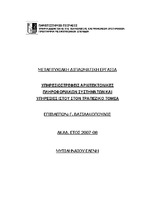Υπηρεσιοστρεφείς αρχιτεκτονικές πληροφοριακών συστημάτων και υπηρεσιών ιστού στον τραπεζικό τομέα

Master Thesis
Συγγραφέας
Μυτιληναίου, Ελένη
Ημερομηνία
2008-04-02Προβολή/
Θεματική επικεφαλίδα
Πληροφοριακά συστήματα -- Διοίκηση και οργάνωση ; Διαδικτυακή τραπεζική ; Τράπεζες και τραπεζικές εργασίες -- ΑυτοματισμόςΠερίληψη
The term task refers to one of the most important concepts in workflow modelling. By identifying tasks, it is possible to structure workflows. A task is a logical unit of work. It is indivisible and is thus always carried out in full. Typing a letter, assessing a valuation report, filing a complaint, stamping a document and checking personal data are all examples of tasks. We can differentiate between manual, automatic and semi-automatic tasks. A manual task is entirely performed by one or more people, without any use of an application. By contrast, an automatic task is performed without any intervention by people. This usually means that an application - a computer program - can carry out the task entirely based upon previously-recorded data. Both a person and an application are involved in a semiautomatic task. A task refers to a generic piece of work, and not to the performance of an activity for one specific case. In order to avoid confusion between the task itself and the performance of that task as part of a particular case, we use the terms work item and activity. A work item is the combination of a case and a task which is just about to be carried out. A work item is created as soon as the state of a case allows it. We can thus regard a work item as an actual piece of work which may be carried out. The term activity refers to the actual performance of a work item. As soon as work begins upon the work item, it becomes an activity. Note that, unlike a task, both a work item and an activity are linked with a specific case.


